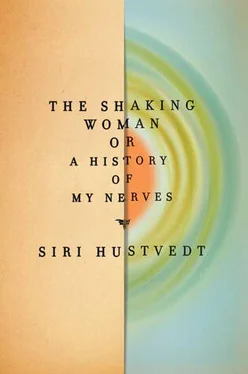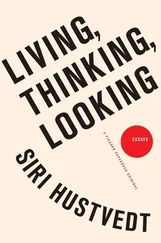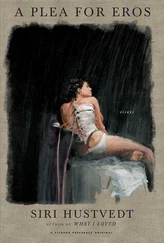Another small story illustrates the emotional, brief, and adamant character of at least one form of hearing a voice, which must emanate from somewhere in the self but is clearly heard as coming from another person. During the siege in Sarajevo, my husband and I had a house guest from that city, a theater director, who had staged one of my husband’s books as a play. Over the course of the few days he spent with us, he told us stories about friendships betrayed, unspeakable acts of cruelty, and the ongoing deprivations of the war. Late one morning, he left our house in Brooklyn for a meeting in Manhattan. I said good-bye to him and returned to work at my desk. A few minutes after I had sat down, I heard him call out, “Help me!” I rushed down two flights of stairs to the door, expecting to see him splayed on the front steps. But there was no sign of him. It had been a hallucination. I had never heard this friend say, “Help me.” The voice, his voice, was not an acoustic memory of a phrase he had uttered, but, I would suggest, as in dreams, it was a condensation of days of remembered dialogue into a single vivid cry for help, unleashed suddenly and involuntarily from a deep, emotional place in my mind.
Since that strange but memorable call for help, the only times I hear voices regularly anymore are at night. As I lie in bed on the threshold between wakefulness and sleep, I often hear both male and female voices utter short emphatic sentences and, every once in a while, my name. Sometimes I tell myself to remember what they have said, but I rarely do. They are the audible ephemera of the time when full consciousness recedes and my mind seems to jump onto two wholly separate tracks: the heard and the seen. Invisible strangers talk in short bursts while I watch the fabulous, often brilliantly colored hypnogogic hallucinations, both figurative and abstract, that pass before my closed eyelids. These are phenomena at the limen of sleep and dreams. Like dreams, they do not feel willed. Unlike dreams, I listen to the voices but never speak back to them, and I watch the visions as an observer, not as a first-person actor. Once, I saw myself in those presleep pictures. At first, I didn’t recognize whom I was looking at, but then I realized that it was an image of my younger self. I was holding my daughter when she was still a baby. Sophie had lain her head on my shoulder, and then, like everything else on that metamorphosing screen, we vanished.
If there is any lesson to be taken from this short tour of transcendent feelings and alien voices, it is how hard it can be to classify the phenomena. Sometimes such experiences are linked to an illness such as epilepsy or to a psychosis; sometimes they aren’t. If they become unbearable to you or to others close to you, you may end up in a hospital for treatment. Otherwise, elevated, even rapturous moods and intermittent voices may simply become integrated into your daily life or find their way into your poetry. They may, in fact, make life feel more rather than less meaningful, and you will inevitably read them from the perspective of your own narrative history. Rumi’s and Rilke’s ecstatic illuminations may share common traits and a physiological ground, but each man’s transports were contextualized in a different way because each man lived inside his own language and culture. What is certain is that it becomes difficult to separate personality from these lived experiences, however curious, especially if they recur, and how one makes sense of them is crucial to living with them.
I RECEIVE A THREE-PAGE single-spaced letter from Dr. L., a description of our meeting and the process ahead. This woman is thorough. A sentence catches my attention: “In summary the history and physical exam indicate that she has classical migraine, occasionally morphing into status migrainosis, and is concerned that she may have temporal lobe epilepsy based on the history and the characteristics of the episodes.” Alas, my life is lived in the borderland of Headache. Most days I wake up with migraine, which subsides after coffee, but nearly every day includes some pain, some clouds in the head, heightened sensitivities to light, sounds, moisture in the air. Most afternoons I lie down to do my biofeedback exercises, which calm my nervous system. The headache is me, and understanding this has been my salvation. Perhaps the trick will now be to integrate the shaking woman as well, to acknowledge that she, too, is part of myself.
I SIT DOWN in the small waiting room of the MRI office with a standard form. The insurance company has approved only the brain MRI, not the one for my cervical spine. When I write down my name and address, I realize I am about to make an error. Under “City,” I almost write Northfield, the town where I grew up, not Brooklyn. I am flabbergasted. I have lived in Brooklyn for twenty-seven years and New York City for thirty. What is going on? Without being conscious of it, I must have traveled to a time in a house I cannot remember. All I have retained of those early days is my first address: 910 West Second Street, Northfield, Minnesota. The interior of that house is purely imaginary, and its occupants are characters I have shaped through the stories told to me by other people. My young mother stands over a feverish baby whose body twitches and jerks. I now live on another Second Street, one in Brooklyn, New York. The gaffe was formed in a mental underground where one town replaced another, two streets became one, and past and present mingled in a single paroxysmal image. What pokes up into daylight is one word: Northfield. As my hand moved the pen across the paper and filled in the information, the habitual act, performed thousands of times since I learned to write, was relocated, as if I were still a girl at my school desk filling in my name and address for the teacher.
WHEN THEY TAPE MY head and slide me into the long tube, I feel anxious. The technician explains that it will take about a half an hour. He gives me a ball to squeeze if I discover I “don’t like it in there”—in other words, if I panic. I don’t like it in there, but I don’t panic. I tell myself to do biofeedback and open myself up to the experience as any good phenomenologist would. Although I am wearing earplugs, the machine’s noise is deafening. I feel I have been immobilized at an extraterrestrial rock concert, the rhythms of which arrive as incessant whacks to my head. I try counting the beats. Three long blasts of sound, then six shorter taps. I can assimilate this pattern, but after that a speed hammer arrives. The concert has turned into a robot on amphetamines using me as his drum. I find it hard to remain still. The sounds slam into my head, but I also feel them in my torso, my arms, and my legs. My face convulses involuntarily, and I emerge dazed after my half hour of encapsulation.
As I leave the building, I am aware of the haze lowering in my head. My vision has changed. Outside, the sunlight hurts. The dizziness arrives, and the nausea. Then sharp pain and the stupefying exhaustion that slows my every step. The MRI has triggered a migraine. The test to search for scars in my brain that would support a diagnosis of epilepsy has knocked that poor organ into familiar territory — the land of Headache. The irony makes me smile. I don’t fight migraine anymore. I embrace it, and by doing that, I am also, strangely, able to feel less pain.
In Gravity and Grace, Simone Weil writes:
Headaches. At a certain moment, the pain is lessened by projecting it into the universe, but the universe is impaired; the pain is more intense when it comes home again, but something in me does not suffer and remains in contact with a universe which is not impaired. 172
Weil, philosopher, mystic, and political activist, struggled with crippling headaches. She was a chronic migraineur whose personality traits strongly resemble those Norman Geschwind linked to temporal lobe epilepsy. She would have to be described as hyposexual; she never had a lover, but she wrote with unflagging energy and was deeply religious. If she had seizures, they were not diagnosed. Geschwind did not believe that his list of traits was limited to epileptics, a fact that both broadens the syndrome and weakens it as a diagnostic tool. Weil was a person of rare intellectual gifts whose experiences led her far from materialism into the realm of extraordinary transcendence. (I suspect she could have unscrambled any image Professor Baruss put before her.) Weil’s life is yet another example of how the neurological and the psychological overlap to shape beliefs, both of a spiritual and a nonspiritual nature, as James argued. Isolating Weil’s migraines from her personality and her ideas can only create false categories, which is not to say that she was made by her headaches. She, like every one of us, was a being who accumulated a self over time. A genetic tendency toward migraine and the ongoing experience of the headaches, as well as the neurological instability that comes with them, were essential pieces in the story of her life, as were Dostoyevsky’s seizures. Epilepsy and migraine do not, of course, belong exclusively to the gifted among us. One person’s hypergraphic outpourings may be brilliant and another’s mere drivel. Illness does not necessarily produce insight.
Читать дальше












